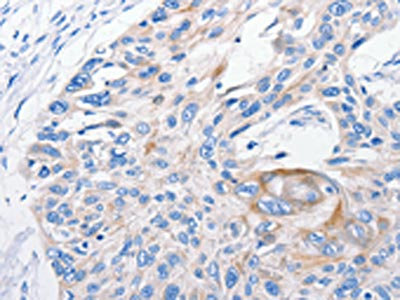
The image on the left is immunohistochemistry of paraffin-embedded Human esophagus cancer tissue using CSB-PA176239(FANCF Antibody) at dilution 1/100, on the right is treated with fusion protein. (Original magnification: x200)
FANCF Antibody
CSB-PA176239
ApplicationsELISA, ImmunoHistoChemistry
Product group Antibodies
ReactivityHuman
TargetFANCF
Overview
- SupplierCusabio
- Product NameFANCF Antibody
- Delivery Days Customer20
- ApplicationsELISA, ImmunoHistoChemistry
- CertificationResearch Use Only
- ClonalityPolyclonal
- ConjugateUnconjugated
- Gene ID2188
- Target nameFANCF
- Target descriptionFA complementation group F
- Target synonymsFAF, Fanconi anemia group F protein, Fanconi anemia complementation group F
- HostRabbit
- IsotypeIgG
- Protein IDQ9NPI8
- Protein NameFanconi anemia group F protein
- Scientific DescriptionThe Fanconi anemia complementation group (FANC) currently includes FANCA, FANCB, FANCC, FANCD1 (also called BRCA2), FANCD2, FANCE, FANCF, FANCG, FANCI, FANCJ (also called BRIP1), FANCL, FANCM and FANCN (also called PALB2). The previously defined group FANCH is the same as FANCA. Fanconi anemia is a genetically heterogeneous recessive disorder characterized by cytogenetic instability, hypersensitivity to DNA crosslinking agents, increased chromosomal breakage, and defective DNA repair. The members of the Fanconi anemia complementation group do not share sequence similarity; they are related by their assembly into a common nuclear protein complex. This gene encodes the protein for complementation group F.
- ReactivityHuman
- Storage Instruction-20°C or -80°C
- UNSPSC41116161






